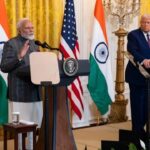President Trump called this ‘Liberation Day’ initiative as a “Declaration of Economic Independence” describing that it would be generative measure for ‘trillions and trillions of dollars to reduce our taxes and pay down our national debt.’ This will increase the jobs for American and higher the domestic production.
‘Liberation day’ as Declaration of Economic Independence
The ‘Liberation Day’ is the day for America to introducing tariff of universal 10% on all imports, put higher tariffs on some specific countries including China with 34% on Goods, Japanese goods have 24%, 20% on Europe import Goods, 46% of Vietnam goods.
Trump’s Goal for New Tariffs
These tariffs made up to shape the future of manufacturing goods for both US and Foreign countries, it would start the production within the US, so this strengthening the domestic industries and cut off the reliance on International supply chain.
$2 Trillion of Peacetime debt and deficits
Vice president JD Vance said on Fox News “This is a big change, but we needed a big change. We cannot keep going down the previous pathway for economic growth, he criticized Joe Biden administration’s legacy where we have $2 trillion of peacetime debt and deficits. The manufacturing is disappearing from the country that is not working for American. The necessity for economic independence and revitalizing US manufacturing”.
What Karoline Leavitt, White House press secretary has to say?
Karoline Leavitt, White House press secretary considering “Liberation Day” was a great day for America and said “Trump delivered on a campaign promise he made to 80 million Americans, this is a national emergency. We have a $1.2 trillion trade deficit. We’ve had 90,000 factories close across our heartland. We’ve had five million manufacturing jobs go overseas since 1997, and President Trump is finally doing something about it than others in the history didn’t do that.
Trump’s long-term benefit can cause short-term damage
Trump is confident about the long-term benefits of these tariffs but some economists seeing this as a threat to the traditional trade, expressing their concerns about potential retaliatory measures and risk of global trade war.
However other than these apprehensions, the administration stood up and delivered the commitment of policies that prioritizing American economic interests and promote the resurgence of U.S. manufacturing.
What is the market reaction?
Markets continue to react on this development as the SDPR Dow Jones Industrial average ETF (DIA) is at 405.22 USD, fell 3.98%, S&P 500 dropped 4.9%, the Nasdaq declined 6% as a result of nearly $3.1 trillion loss in a market. As everyone is feared after the downfall of stock market after new tariffs on almost all US imports.
Read also: Asian equity markets
Companies that were hit heavily
Most of the major technologies company were hit by this development including Apple shares fall 9%, Tesla experienced declined by 4%, and Nvidia dropped around 5%. These markets situation reflects on the investors, they concerns about retaliatory measures from trading partners and the broader trade tensions impacted by economic fluctuations.
Conclusion
- Trump delivered the promise for economic independence and revitalizing US manufacturing in the country.
- Liberation Day as declaration of economic independence, aim of the new tariffs announcement to increase manufacturing sector jobs and higher the domestic production.
- Cutting the imports from other countries made more economically Independence
- Many economists said that it will spark the retaliatory measures and global trade war.
- Vice president JD Vance thought that this change is a necessity measure to take which previous administration didn’t take for the country peacetime debt and deficit.
- The markets still dropped by 10-49%, investors are moving away their money.









